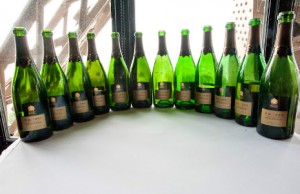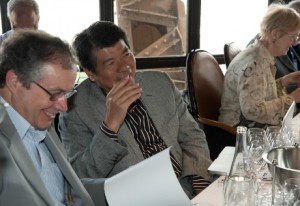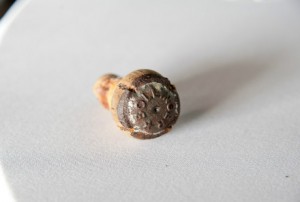A legendary tasting of Bollinger R.D.
Author: Berry Bros. & Rudd
In the course of a career in the wine trade one can expect to attend a few tastings which might fall into the category of “special” but in July I was privileged to attend a presentation which will live long in the memory, and must rank as one of the most extraordinary in my 35-year wine trade career.
privileged to attend a presentation which will live long in the memory, and must rank as one of the most extraordinary in my 35-year wine trade career.
It will come as little surprise that the organiser was Champagne Bollinger, who decided to mark the 50th anniversary of the London launch of their prestige cuvée, Bollinger R.D. The House decided to pour 12 vintages of R.D., starting with the inaugural year of 1952 and running through to 1997. All the wines were disgorged in February 2011, except the 1952 which had been disgorged in 1969.
The tasting took place in the Michelin-starred restaurant Jules Verne, halfway up the Eiffel Tower, not the easiest place to get to, served by a single, small lift, but blessed with glorious views once you get there. Bollinger’s Chef de Cave, Mathieu Kauffman, was on hand to talk us through the various wines, explaining the vagaries of each year’s weather which contributed to the style.
 I append full tasting notes below but the overriding impression was one of amazing freshness and vitality in the wines, even those of more than 40 years of age.
I append full tasting notes below but the overriding impression was one of amazing freshness and vitality in the wines, even those of more than 40 years of age.
Those attending came from all around the world and comprised a cross-section of top wine journalists, principals from the House of Bollinger, members of the Broccoli family, marking the House’s long association with the James Bond films, a top London sommelier, myself and some leading wine bloggers. Hardly any of these vintages can still be found commercially so it was a rare treat indeed to be invited to taste them.
My warmest thanks to Bollinger for an unforgettable experience.
1997
Yeasty, bready nose with fabulous aromas of stone-fruit, Mirabelle plum and peach. On the palate a honeyed ripeness, soft peachy fruit, wonderful maturity, hints of caramel. Quite buttery, then fine acidity on the finish.
1996
Quite closed and backward on the nose. Marvellous harmony and balance on the palate. Still extraordinarily youthful, lots of vigour. Red fruit character much to the fore, raspberry and red cherry. Great length.
Restrained, fine, elegant nose, hints of red fruit jam with orange peel. Beautiful purity of fruit, much more evolved than the 1996. Magnificent richness, very complete and long. Ready to drink now.
1990
As one would expect from this hot year, a pronounced aroma of exotic fruit  with a strong counterpoint of wild mushrooms, especially cèpes and mousserons; baked apples, roasted nuts and honey also much in evidence. On the palate hints of caramel and vanilla point to great ripeness in the fruit, with citrus peel and Asian spice adding to the complexity. Powerful, long finish.
with a strong counterpoint of wild mushrooms, especially cèpes and mousserons; baked apples, roasted nuts and honey also much in evidence. On the palate hints of caramel and vanilla point to great ripeness in the fruit, with citrus peel and Asian spice adding to the complexity. Powerful, long finish.
1988
Deep gold colour, honeyed but very fresh, youthful nose, with notes of fruits-in-liqueur, mushrooms and brioche. Very, very fine on the palate, with ripe yellow plum and white peach, followed by piercingly fresh lemon-peel acidity on the finish. Amazing length. A personal favourite from a very strong field!
1985
Deep gold colour; pronounced musky nose of mushroom hazelnuts and citrus peel, with one taster spotting ginseng. Others found white truffle, hints of coffee; more exotic fruit than was found in the more classical years such as 1988 or 1996. Very fine acidity and a long, persistent finish.
1979
Aroma of macerated yellow stone-fruits, plums and nectarines. Notes of honeyed almonds and hazelnuts on the palate, excellent freshness and lively youthfulness. Great persistence and balance, exceptional length.
1976
A very hot summer, and yet surprisingly some slightly green, vegetal notes on the bouquet. On the palate, however, immense richness and depth. Still remarkably unevolved for such a hot year. Not quite as well-knit and harmonious as some but still considerable zest and length.
1966
A tiny crop, after hail wreaked havoc in the vines. Aromas of mushrooms, dried apricot, hazelnuts and oranges-in-brandy. Very saline and mouth-watering. Wonderful freshness. A lot of the sparkle has gone so the quality of the base wine is revealed in all its glory, and outstanding it is, too. Extraordinary length.
1961
Deep gold. Very hard to write a note as this was sheer perfection. Winey, vinous, long, round and harmonious. Mozart in a glass.
1959
Smoky, honeyed, spicy, yeasty, bready nose. Very full and powerful on the palate. Very opulent, not quite the freshness of the 1961. A hot summer brought the grapes to excellent maturity and, if anything, this has lent the wines a touch of heaviness on the finish with the acidity only moderate.
1952
Noble rot in September has imbued the bouquet with exotic notes, honeyed apricot and peach. Roasted nuts are in evidence and, for the only occasion in this tasting, coconut. Lovely velvet texture in the mouth, the acidity slightly low as one would expect from botrytis-affected fruit, but still a remarkable wine at nearly 60 years of age.



A beautiful article, An incredible experience.
I have a question that might be slightly embarrassing.
I wasn’t that lucky to taste all the vintages have been mentioned but due to my personal experience (1988, 1995, 1996, 1997 and 1999) what came out to me was the impression that both 1997 and 1999 are different. The richness and powerfulness are acting a leading role much more than they use to do in past. The last two vintages are different from the other but I’m afraid that the RD style is changing.
Does this make any sens to you?
Thank you,
Jovica
Thank you for your comment. Not sure really if the style of RD is changing; after all, RD is only the Grande Annee with more lees ageing. 97 and 99 were both warm years where the fruit was ripe, and this leads to wines with a high degree of natural richness.1996 , by contrast, was a year of high acidity becasue of cool nights in late summer, so the style is quite different. I’ll ask Bollinger if they are consciously changing the style, but somehow I doubt it. Let’s see how the 99 evolves in time as it is still quite young by the standards of what we tasted in Paris.
Let’s see what the evolution of the 99 will be, waiting the next classic RD vintage. I imagine 2002 could be potentially the closest one.
Thanks for your answer.
Jovica
I read your article about Bollinger RD with interest. There were several vertical tastings organized by Bollinger during 2010 and 2011 (see posts by Jancis Robinson, Decanter, and others) all of which have involved wines going back as far as 1959, but in most cases only actually disgorged a few months prior to the tasting. I recently opened a bottle of 1976 RD, disgorged at the time of its general release in the late 1980s, and with impeccable storage up until now (2012). I have to say I was disappointed, as the experience was nothing to compare with those described by yourself and others regarding this particular vintage. It may have been a bad bottle, and I am no expert, but I do wonder whether the timing of disgorgement is critical to the experience. This is important, because these vertical tastings involve disgorged wines that most people will never have access to, and could create the impression that RD wines can age for much longer than they actually will once in their final bottle. Do you have a comment on this?
Adam
Thank you for your comment about Bollinger RD. I think the timing of disgorgement is critical to the enjoyment of these wines. There is a belief in some circles that once vintage Champagne is disgorged and has had a few more years of ageing in bottle than its evolution is more or less complete and it will not improve further. The thinking is that most of its maturation is done in bottle pre-disgorgement and it is therefore ready to drink when released. Others maintain that although it is ready to drink when released good vintage Champagne still has the potential to age and improve with maturation for many years.
Part of this is subjective opinion, of course; the British are renowned for liking an old style of Champagne with advanced tertiary aromas, while the French and Italians, for example, prefer a much fresher style with crisper acidity.
I have drunk many old bottles of Champagne, sometimes decades after disgorgement, and found some to be fascinating, and still very much alive, while others were totally moribund. As a general rule I feel that any Champagne, no matter how good to begin with, will struggle to retain its quality for more than 20 years after disgorgement. It might still be interesting in an academic way but will surely have lost much of its fruit. Retaining the sediment for extended ageing, as happened with the range of Bollinger RDs in this tasting, is what enables the wine to remain nourished and still developing. So your experience of drinking a 1976 RD this year which had probably been disgorged in 1988, or thereabouts, is disappointing but not altogether surprising. 24 years post-disgorgement ageing is a challenge for any Champagne in terms of its ability to retain its fruit and vitality. Knowing disgorgement dates is critical to the enjoyment of long-stored Champagne and it’s good to see more houses putting this information on the label. The 1976 which I drank at the Paris tasting had been disgorged 5 months earlier so that explains why its freshness was still so vibrant.
I hope this proves helpful and thank you for raising the issue.
Best regards
Alun
i have a bottle of bollinger r.d 1976.has been carted from house to house over 20 years so storage has been suspect.do i just throw it away.thanks in advance for any advice as i have no idea
I was there too , thanks to remind me these beautiful eperience
According my notes I found the 61 the most remarkeable